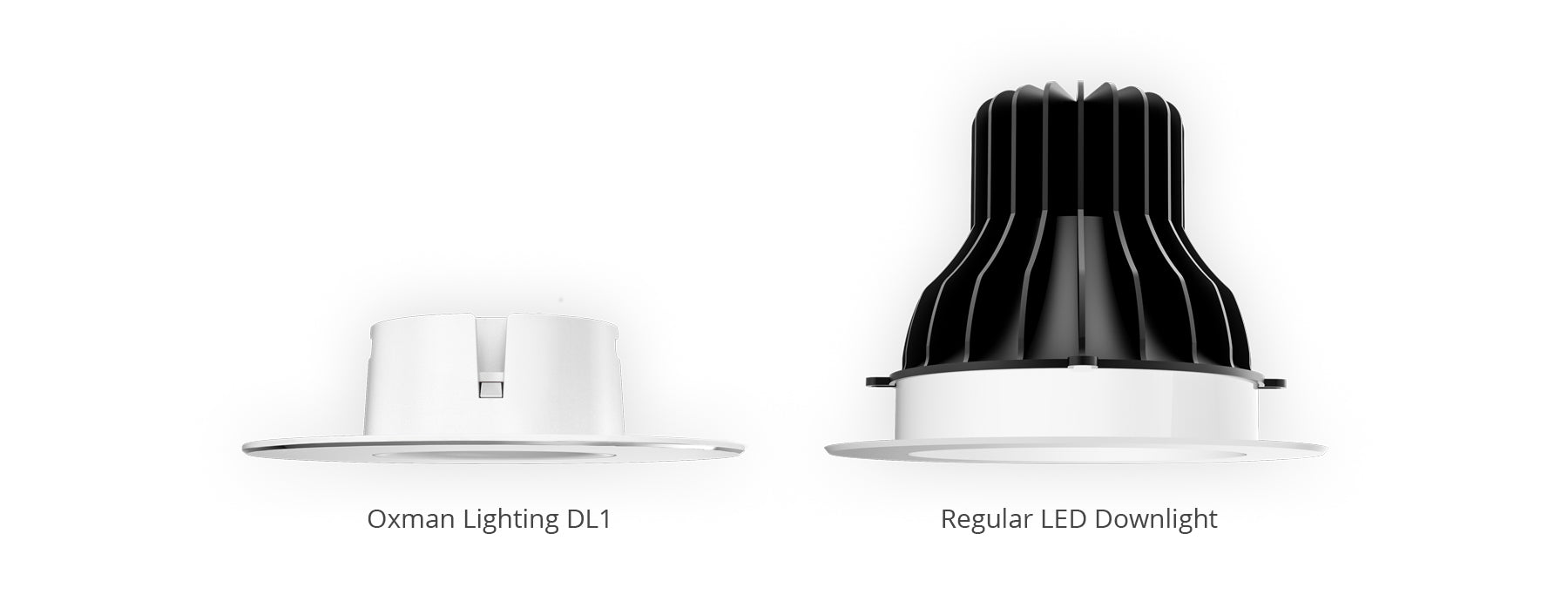Your Cart is Empty
FREE AU & NZ SHIPPING WHEN YOU SPEND $200 // AUSTRALIAN OWNED AND DESIGNED

The tangible results of this superior cooling concept are:
| > | Reduced use of raw materials; lower weight | |
| > | Better cooling effect | |
| > | Compact downlight body with low profile | |

The concept uses a low weight Total Surface Heat ExchangerTM, an LED array as well as a framed silicone lens for protection and light guidance with an optical efficiency of 90%. Its key features are competitive simplicity and efficiency!
It transfers the heat directly from the LED base and heat exchanger to the cooling agent by convection and by additional conduction.
For the thermal management of LEDs, other available fittings utilise finned heat sinks with low thermal efficiency and high material usage. Their performance depends on their orientation and their comparatively high mass stores the heat before using the finned surface to dissipate heat by convection. Measurements on conventional downlight heat sinks confirm that there is an unwanted temperature gradient of up to 20°C from the base of the LED to the tip of the cooling fin. This reduces the active temperature difference between the heat sink surface and the ambient cooling air, thereby decreasing the cooling effect. A temperature gradient in the heat sink of 10°C reduces the cooling effect by about 20%. This has all been verified by thermal testing and it explains why the heat sinks have to be so big; a reduced temperature difference necessitates a larger cooling surface in order to achieve the required heat removal. The aim of the Total Surface Heat ExchangerTM concept is to avoid heat storage and instead transfer the heat from the hot base of the LEDs to the ambient cooling air in the shortest and most efficient way.
The cooling process in the Total Surface Heat ExchangerTM concept is achieved by unobstructed convection of the ambient cooling air past the smooth cooling surface of the heat exchanger and its ability to extract heat directly from the LED mounting base. The LEDs are directly attached to the heat exchanger, which, on the reverse side, creates the high temperature difference that drives the convective cooling process so effectively. Virtually the entire surface area of the thin and low mass heat exchanger contributes to cooling. The framed silicone lens provides some additional surface cooling for the LEDs as it is in contact with the LED base. A minor contribution for cooling comes from radiation.
Cooling is primarily achieved by convection and conduction; these rely on 3 key factors, each of which is optimised in the Total Surface Heat ExchangerTM concept to achieve most effective cooling:
| Key Factor | HOW IT IS OPTIMISED in the Total Surface Heat ExchangerTM concept | |
| 1 | The temperature difference between heat source and ambient cooling air. This is the driving force. |
The total surface of the heat exchanger, particularly directly under the LEDs, operates at the highest possible temperature difference to drive efficient cooling. |
| 2 | The surface area of the heat exchanger is in direct contact with the ambient cooling air and with the mounting surface. The LED base is in contact with the silicone lens. This is the cooling area. |
The heat exchanger contributes to the cooling process with its entire surface area and the silicone lens provides additional surface cooling for the LED chip through contact with its base. |
| 3 | The velocity and volume of the cooling air over the surface of the heat exchanger and silicone lens, also the thermal conductivity between heat exchanger and the mounting surface. These determine the rate of heat removal. |
The smooth surface of the heat exchanger supports the uninhibited flow of the cooling air, which is unlimited and enables direct contact with the plane mounting surface for heat transfer. |
The Total Surface Heat ExchangerTM concept minimises the use of material and maximises the overall efficiency of the cooling process. The excellent performance of a complete LED down light using this concept has been confirmed through detailed testing.
For the Oxman DL1 downlight, an environmentally and technically favourable weight to output power ratio has thus been achieved. It is a 14W LED downlight fitting using the Total Surface Heat ExchangerTM concept.
As a result it weighs just over 100g, produces an output of 1200 lumens and achieves an L95 lifetime of over 66,500 hours in 45°C; far superior to other downlight fittings.
